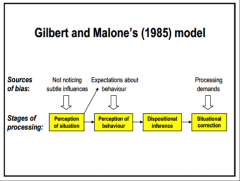![]()
![]()
![]()
Use LEFT and RIGHT arrow keys to navigate between flashcards;
Use UP and DOWN arrow keys to flip the card;
H to show hint;
A reads text to speech;
17 Cards in this Set
- Front
- Back
|
What is attribution theory? |
The theory of how people (OBSERVERS) explain the causes of their own and others' (ACTORS) behaviour. It focuses on the observer's judgements rather than the actor's actual behaviour. |
|
|
What is it to 'make an attribution' |
To infer or perceive causes of behaviours (in the person or situation) |
|
|
What is the naïve scientist metaphor? |
Laypeople are motivated to predict and control others' behaviour by uncovering the underlying causes of observed behaviour. This is done using rigorous and logical principles. |
|
|
What is Kelly's (1967) covariation theory? |
Correlation is used to infer causation: the effect is attributed to that condition which is present when the effect is present and is absent when the effect is absent. |
|
|
What three factors of covariation need to be considered when making attributions? |
Persons - consensus information Entities - distinctiveness information Contexts - consistency information |
|
|
What combination of consensus, distinctiveness and consistency levels would prompt an attribution to be made to an individual? |
Low consensus, low distinctiveness, high consistency |
|
|
What are the limitations of the covariation theory? |
1. People don't usually ask for covariation information when trying to explain an actor's behaviour. 2. explicit presentations of covariation information that result in conclusions in line with the theory are not ecologically valid. 3. covariation information doesn't fully answer cause questions 4. people don't tend to 'start from scratch' they draw on prior knowledge and expectations 5. covariation information is not always available |
|
|
Explain attributional bias |
Attribution is biased when people show a systematic tendency to favour certain explanations over others. These biases can but don't necessarily lead to error. |
|
|
What is the correspondence bias? |
1. It is the fundamental attribution error 2. It is the tendency to conclude that a person has a disposition that corresponds to their behaviour even when this behaviour is attributable to the situation |
|
|
Why is the 'attribution error' now referred to as a 'bias'? |
Often this bias leads to correct inferences rather than errors. |
|
|
Describe the 'invisible advantage' experiment conducted by Ross, Amabile & Steinmetz, 1977 |
1. participants are randomly allocated to the role of questioner or contestant in a quiz game simulation Questioner: devised 10 challenging general knowledge questions based on their personal interests and experience Contestant: attempted to answer questions in the allotted time Both: then rated their own and their partner's general knowledge Contestants rated questioners' GK as higher than their own, clearly not taking into consideration the invisible advantage that comes with being able to pick the questions |
|
|
Describe Gilbert and Malone's 1985 model of the correspondence bias |

|
|
|
Name two of the biases that affect social information processing |
false consensus bias self-enhancement bias self-other bias |
|
|
Describe the 'self-other bias' i.e. the actor-observer differences |
there is a tendency for actors to attribute their actions to situational requirements whereas observers tend to attribute the same actions to stable personal dispositions. |
|
|
Describe Storm's 1973 experiment testing perspective effects and actor-observer differences. |
1. male participants had a 'get acquainted' conversation while observers watched. 2. one group of actors and observers then saw a video of the conversation. The other group did not. 3. In the video condition, either the same or a new perspective was shown - i.e. the same or the other actor was shown. 4. In the no-video and same-perspective conditions, dispositional attributions are more prevalent 5. in the opposite-perspective condition, the self-other bias is reduced for the observer and situation attributions are more prevalent. |
|
|
Talk about the ubiquity of the correspondence bias and actor-observer differences. Reference studies. |
Correspondance bias: not empirically proven ubiquity across situations and cultures. Different biases are prevalent in different situations. Gilbert & Malone, 1985 Actor-observer differences: Malle 2006 found little evidence for a strong and pervasive A-O difference in his meta-analysis. It was dependent on the positive (dispositional) or negative (situational) valence of the situation and on the idiosyncrasy of the actor. |
|
|
Why do we have these biases? |
They are often accurate - if they weren't we wouldn't use them Inaccuracies relative to what? Even errors might make sense from an evolutionary and socially acceptable perspective
|

